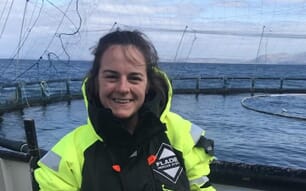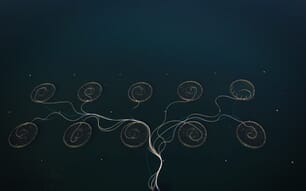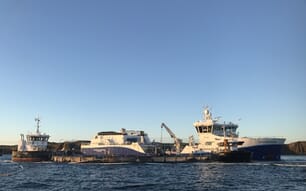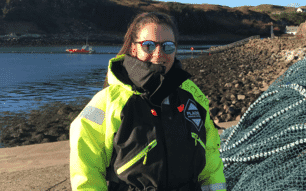A lot has changed on Muck’s fish farm over the past few weeks. When we came back on shift, four new pens had been added to the grid, increasing the site from six to 10 pens in total. This meant some more firsts for me. From fitting nets and lice skirts to connecting power cables and feed pipes, there was a lot to get ready before the salmon could be moved in.
On our first weekend, we had a run of great weather and the wellboat the Inter Caledonia arrived on site to allow us to split down the salmon across the 10 pens. This is required to allow maximum biomass to be achieved, so that the fish have the right amount of space needed to grow and to comply with welfare standards.
Whilst the Inter Caledonia was on Muck, we also took the opportunity to give the salmon a three-hour freshwater bath. This is a natural method for the treatment and removal of sea lice as well as the prevention of amoebic gill disease, and, as it relies purely on freshwater and not medication or chemicals, there are no environmental implications. Being an anadromous species (meaning they spend parts of their life in both fresh and seawater) the salmon are able to cope with this change in water environment without negative side effects.
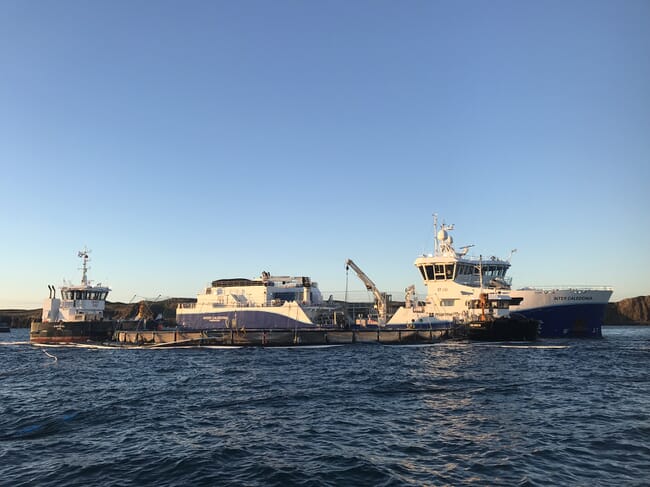
© Clara McGhee
As well as our own site boat, the Beinn Airein, the Askival came across from the fish farm on the neighbouring island of Rum, along with two crew. For two-and-a-half days, we lifted the base and all associated winches, ropes and chains, followed by the nets of each pen. A float line was then run around to crowd the fish and allow them to be taken onto the wellboat. Once on board, the pens were put back to normal and it was straight onto the next one whilst the fish were treated prior to discharge.
I was lucky enough to have a tour around the Inter Caledonia and the level of technology on board was hard to comprehend. Unlike most wellboats that need to pump on freshwater from lochs, the Inter Caledonia creates its own through reverse-osmosis technology. Pumping seawater from depths largely devoid of algae, the boat can create 200 cubic metres of freshwater in an hour, and fill both of its wells in 10 hours. Not only does this make the Inter Caledonia more time and cost effective as it doesn’t have to travel to lochs between farm sites to refill, it also means that the freshwater used is much clearer and thus better for the fish. The crew even claimed that their water was purer than that out of our taps!
For me, I had a number of light-bulb moments over that couple of days. As I’ve said before, until you’ve actually done something, I don’t think you can really understand it. But finally, things that I’d been taught at university or that had been explained to me multiple times on site began to make much more sense as I saw them happening before my eyes.
Once the fish were all safely split across the pens and the Inter Caledonia had set off, a spell of bad weather rolled in and we thought we would be stuck ashore for a few days. However, problems with the barge and some of the underwater cameras meant that we couldn’t feed properly from the shore base, so we headed out to site in pretty choppy conditions to check the pens and get things working again. It’s in these moments that you realise just how exposed the Muck site is, as well as the efforts that farm staff make for the wellbeing of the salmon… whatever the weather.
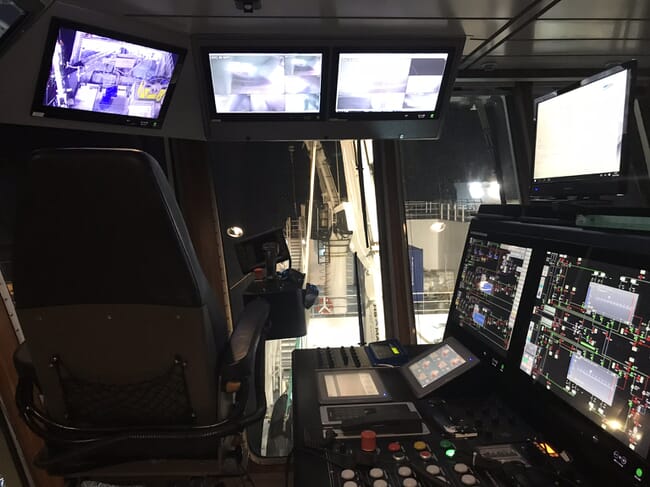
© Clara McGhee
But it’s not just on Muck that things have evolved recently. Two reports have been published in the past month that hold significance for the future of the Scottish salmon industry. Firstly, SEPA launched their draft Finfish Aquaculture Sector Plan, outlining the new ways in which they propose to regulate and ensure compliance across the industry.
Secondly, the Scottish Parliament’s Rural Economy and Connectivity (REC) Committee published the outcome of its inquiry into Scottish salmon farming. The committee’s main conclusion was that if the industry wants to expand, changes to regulation are needed, particularly in areas surrounding fish health and the environment, and the report presents 65 recommendations to achieve this.
One of the most common arguments made against Scottish salmon farming is that it is poorly regulated and has disappointing levels of compliance. However, having spent a large part of my MSc researching this exact topic, I think the industry is actually one of the most heavily regulated in Scotland. The issue is more that existing regulation is fragmented and not fit for purpose, and for this reason, the industry struggles to achieve compliance at all times.
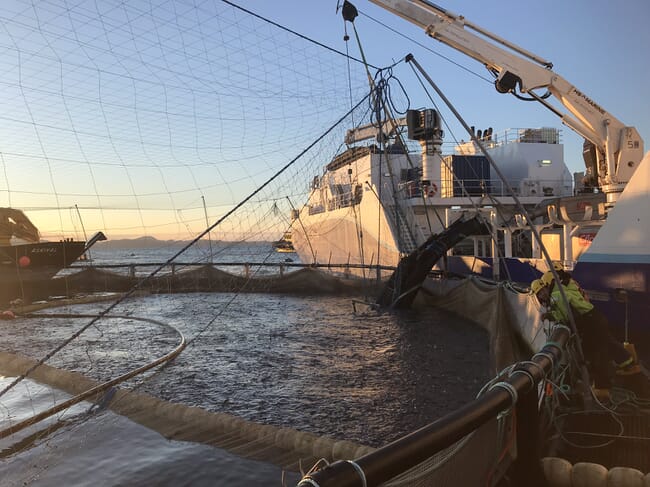
© Clara McGhee
For those not involved in salmon farming, I think it is worth highlighting that the majority of regulation that governs it at present – both planning and environmental licensing – is based on policies originally designed for land-based developments and point source pollution discharges to freshwater environments. For years, salmon farms have sought to comply with regulation that is not specific to their operations or the unpredictable and dynamic nature of the marine environment. Furthermore, as the industry has grown, developed and evolved in Scotland, the regulation has stayed the same. It is therefore unsurprising, in my opinion, that levels of non-compliance exist.
I think that both SEPA’s draft Sector Plan and the recommendations made by the REC Committee are a big step in the right direction towards overcoming these regulatory challenges, and, importantly, they are based on science. Like any form of farming, the industry expects science to lead the regulation that governs our business operations. A tailored approach to regulating the industry and its specific practices and environments can only mean progress and it is reassuring to see similar proposals in both reports.
What is also reassuring is that the responses from both the industry and those who actively campaign against it have been largely positive and there appears to be some measure of agreement on the future direction of the sector from all parties.
Whilst the salmon farming debate can often become highly contentious, I think it is important to recognise that, fundamentally, the priorities of all stakeholders are the same. Everyone sees the value and importance of protecting the marine environment, maintaining high levels of fish health and welfare and safeguarding wild fish populations. Any change to regulation that can support and encourage the industry to further improve in these areas – whilst also achieving compliance – is positive no matter what side of the salmon farming fence you sit on, and these changes are being welcomed unanimously by salmon producers across Scotland. This is hopefully the start of a new era for Scottish salmon farming and I, for one, am excited to see where it goes.

